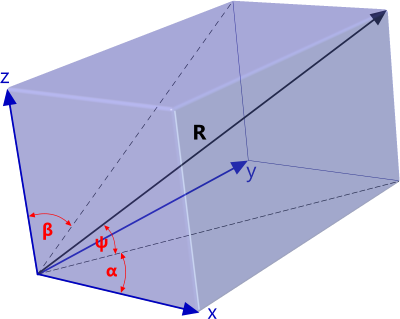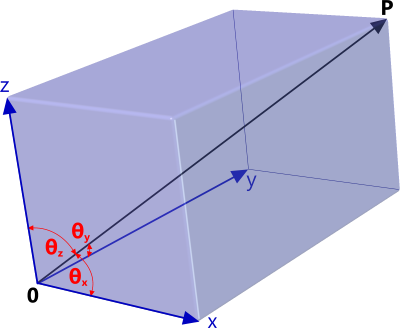Trigonometric Functions
(alternative & compound formulas)
Sin = O/H & Csc = 1/Sin
Cos = A/H & Sec = 1/Cos
Tan = O/A & Cot = 1/Tan
Where: O = opposite, A = adjacent & H = Hypotenuse
The following table contains equivalent or alternative ways to express trigonometric compound formulas.
Sin(x) = x - x³/3! + x⁵/5! - x⁷/7! + x⁹/9! - x¹¹/11! + x¹³/13! - x¹⁵/15! +… etc. |
Cos(x) = 1 - x²/2! + x⁴/4! - x⁶/6! + x⁸/8! - x¹⁰/10! + x¹²/12! - x¹⁴/14! +… etc. |
Sinh(x) = x¹/1 + x³/3 + x⁵/5 + x⁷/7 + x⁹/9 + x¹¹/11 + x¹³/13 + .... |
Cosh(x) = 1 + x²/2 + x⁴/4 + x⁶/6 + x⁸/8 + x¹⁰/10 + x¹²/12 + x¹⁴/14 + .... |
Cosine Rule: A² = B² + C² – 2.B.C.Cos(a) |
Sine Rule: A/Sin(a) = B/Sin(b) = C/Sin(c) |
Cos²(x) = 1 – Sin²(x) |
Sin²(x) = 1 – Cos²(x) |
Tan²(x) = Sec²(x) - 1 |
Cos²(x) + Sin²(x) = 1 |
Tan(π/3) = √3 |
Cos(2x) = Cos²(x) – Sin²(x) = 1 – 2.Sin²(x) = 2.Cos²(x) – 1 |
Sin(x/2) = ±(½(1 – Cos(x)))½ |
Sin(x) = 2.Sin(x/2).Cos(x/2) |
Sin(2x) = 2.Cos(x).Sin(x) |
½Sin(2x) = Sin(x).Cos(x) |
Tan(x/2) = Sin(x)/(1+Cos(x)) = (1-Cos(x))/Sin(x) |
Tan(x) = Sin(x) / Cos(x) |
Tan²(x) = Sin²(x) / Cos²(x) |
Tan(2x) = 2.Tan(x) / (1 – Tan²(x)) |
Cos(x/2) = ±(½(1 + Cos(x)))½ |
Cos(x) = (1 – Sin²(x))½ |
Sin(x) = (1 – Cos²(x))½ |
Tan(x) = Sin(x) / (1 – Sin²(x))½ |
1/Cos²(x) = 1 + tan²(x) |
Sin(x).Cos(x) = ½.Sin(2.x) |
Sin(x).Sin(y) = ½(Cos(x-y) - Cos(x+y)) |
Sin(x).Cos(y) = ½(Sin(x+y) + Sin(x-y)) |
Cos(x).Sin(y) = ½(Sin(x+y) - Sin(x-y)) |
Cos(x).Cos(y) = ½(Cos(x+y) + Cos(x-y)) |
Sin(x + y) = Sin(x).Cos(y) + Cos(x).Sin(y) |
Cos(x + y) = Cos(x).Cos(y) – Sin(x).Sin(y) |
Tan(x + y) = Tan(x)+Tan(y) / (1 – Tan(x).Tan(y)) |
Sin(x – y) = Sin(x).Cos(y) – Cos(x).Sin(y) |
Cos(x – y) = Cos(x).Cos(y) + Sin(x).Sin(y) |
Tan(x – y) = Tan(x) – Tan(y) / (1 + Tan(x).Tan(y)) |
Sin(x) + Sin(y) = 2.Sin(½(x + y)).Cos(½(x – y)) |
Cos(x) + Cos(y) = 2.Cos(½(x + y)).Cos(½(x – y)) |
Tan(x) + Tan(y) = Sin(x + y) / Cos(x).Cos(y) |
Sin(x) – Sin(y) = 2.Cos(½(x + y)).Sin(½(x – y)) |
Cos(x) – Cos(y) = –2.Sin(½(x + y)).Sin(½(x – y)) |
Tan(x) - Tan(y) = Sin(x – y) / Cos(x).Cos(y) |
Sin²(x) + Cos²(x) = 1 |
Tan(x) = (Sec²(x) – 1)½ |
Cot(x) = (Csc²(x) – 1)½ |
Sin(Acos(x)) = Cos(Asin(x)) = (1 – x²)½ |
Cos(Atan(x)) = 1 / (1 + x²)½ |
Tan(Acos(x)) = (1 – x²)½ / x |
Sin(Atan(x)) = x / (1 + x²)½ |
Tan(Asin(x)) = x / (1 – x²)½ |
Cosh(x) = ½(ex + e-x) |
Cosh(x) + Sinh(x) = ex |
Cosh²(x) – Sinh²(x) = 1 |
Sinh(x/2) = ±(½(Cosh(x)-1))½ |
Sinh(x) = ½(ex – e-x) |
Cosh(x/2) = (½(Cosh(x)+1))½ |
Cosh(x) – Sinh(x) = e-x |
Cosh²(x) + Sinh²(x) = Cosh(2x) |
Tanh(x/2) = (Cosh(x)-1)/Sinh(x) = Sinh(x)/(Cosh(x)+1) |
Tanh(x) = Sinh(x) / Cosh(x) = (ex – e-x)/(ex + e-x) = (e2x – 1)/(e2x + 1) |
Csch(x) = 1/Sinh(x) = 2 / (ex – e-x) |
Sech(x) = 1/Cosh(x) = 2 / (ex + e-x) |
Coth(x) = (ex + e-x) / (ex – e-x) |
Asinh(x) = logₑ(x + (x² + 1)½) |
Acosh(x) = logₑ(x + (x² – 1)½) |
Atanh(x) = ½ Logₑ((1 + x) / (1 – x)) |
Asinh(x/a) = logₑ((x + (x² + a²)½) / a) |
Acosh(x/a) = logₑ(x + (x² – a²)½) / a) |
Atanh(x/a) = ½ Logₑ((a + x) / (a – x)) |
3-D Trigonometric Functions and Relationships
3D Angles and Lengths

3D Angles and Lengths
R² = x² + y² + z² |
Sin²(α) / Tan²(ψ) = 1 / Sin²(β) - 1 |
Direction Cosines

Direction Cosines (l, m and n)
l = Cos(θx) = x/P |
m = Cos(θy) = y/P |
n = Cos(θz) = z/P |
Further Reading
You will find further reading on this subject in reference publications(19)